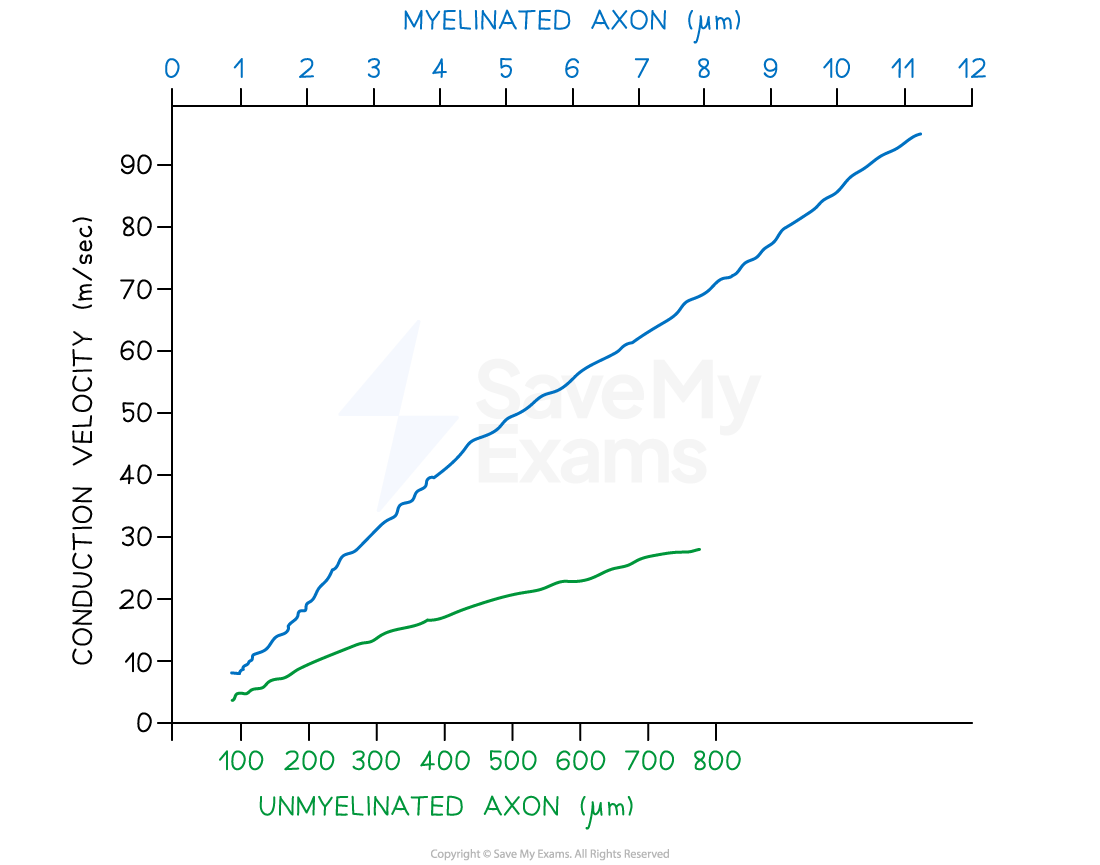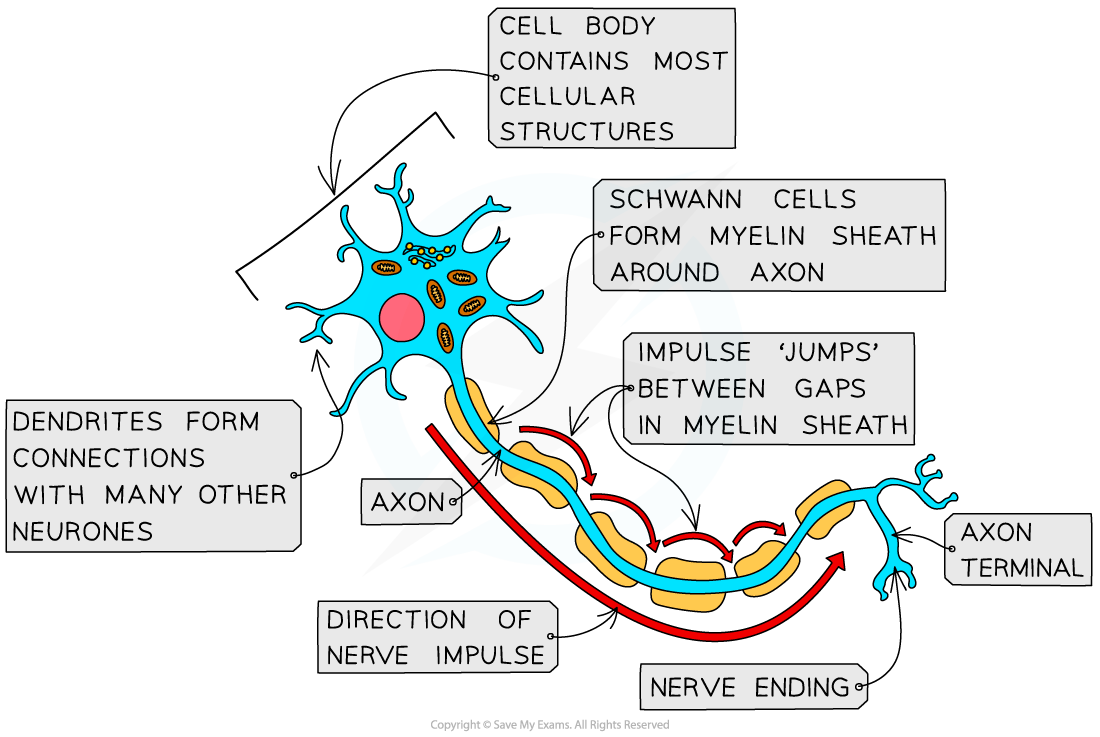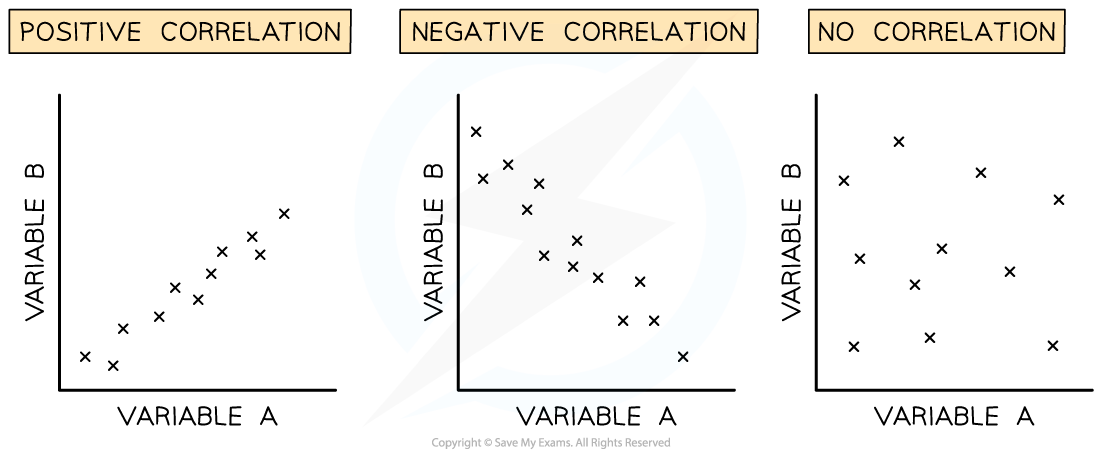Nerve Impulses: Skills (DP IB Biology): Revision Note
Speed of Nerve Impulses
Comparing the speed of transmission
There are well documented correlations between specific structural features of neurones and the speed of transmission
Two key features that should be considered include
Myelination of the neurone
Myelinated neurones conduct electrical impulses much more quickly than unmyelinated fibres
This is because of the insulation offered by the myelin sheath which allows faster saltatory conduction along the neurone
Diameter of the neuron
An axon with a wider diameter conducts an electrical impulse more quickly than a narrow axon
This is because a wider axon offers less resistance to the action potential
Squid have giant axons which are unmyelinated and can be up to 1 mm wide, whereas the average diameter of a human neurone is somewhere between 4 and 100 µm
The graph shows the relationship between axon diameter and speed of transmission in a giant unmyelinated axon from a squid and a 'normal' sized myelinated axon of a mammal
Despite the axon being significantly wider, the speed of transmission is much faster in the axon which is insulated by a myelin sheath
Comparing Speed of Nerve Transmission Graph

Unmyelinated axons have a much slower speed of conduction compared to a myelinated axon
Myelination
Neurones have a main, long, fibre known as an axon
The axons of neurones are surrounded by specialised cells called Schwann cells
Schwann cells wrap themselves around the axon, forming a structure known as a myelin sheath
Myelin contains the phospholipids of the Schwann cell membranes; it is built up in layers as the Schwann cells grow around the axon
The lipid content of the myelin sheath gives it a high electrical resistance
The myelin sheath acts as an electrical insulator; impulses cannot pass through the myelin sheath
The myelin sheath has small, uninsulated sections in the gaps between the individual Schwann cells
These gaps are called nodes of Ranvier
Electrical impulses effectively jump from one node of Ranvier to the next
This process is known as saltatory conduction
It greatly speeds up the rate of transmission of impulses along myelinated neurones
In non-myelinated neurones the axon is not insulated by myelin, so the impulse travels more slowly
Diagram to show the myelination of neurones

An impulse travels down a neurone via saltatory conduction
Describing a correlation using a correlation coefficient
When studying the relationship between two variables such as diameter or myelination and speed of transmission, it is important to collect data which allows us to analyse the strength of the correlation
Correlation is an association or relationship between variables
There is a clear distinction between correlation and causation: a correlation does not necessarily imply a causative relationship
Causation occurs when one variable has an influence or is influenced by, another
For the variables discussed here:
There may be a correlation between diameter of a neurone and the speed of impulse conduction
There may be a correlation between the myelination of a neurone and speed of impulse conduction
The apparent correlation between variables can be analysed using scatter graphs and different statistical tests
Correlation between variables
In order to get a broad overview of the correlation between two variables the data points for both variables can be plotted on a scatter graph
The correlation coefficient (r) indicates the strength of the relationship between variables
Perfect correlation occurs when all of the data points lie on a straight line with a correlation coefficient of 1 or -1
Correlation can be positive or negative
Positive correlation: as variable A increases, variable B increases
Negative correlation: as variable A increases, variable B decreases
If there is no correlation between variables the correlation coefficient will be 0
Correlation in Data Graphs

Different types of correlation in scatter graphs
The correlation coefficient (R) can be calculated to determine whether a linear relationship exists between variables and how strong that relationship is
The coefficient of determination (R2) can then be calculated to test the strength of the association between the variables
Pearson's linear correlation
Pearson's linear correlation is a statistical test that determines whether there is linear correlation between two variables
The data must:
Be quantitative
Show normal distribution
Method:
Step 1: Create a scatter graph of data gathered and identify if a linear correlation exists
Step 2: State a null hypthessis
Step 3: Use the following equation to work out Pearson’s correlation coefficient r
If the correlation coefficient r is close to 1 or -1 or the then it can be stated that there is a strong linear correlation between the two variables and the null hypothesis can be rejected
R = n
∑x = total of the first variable value
∑y = total of the second variable value
∑xy = sum of the product of the first and second value
∑x2 = sum of the squares of the first value
∑y2 = sum of the squares of the second value
The coefficient of determination
The to find the coefficient of determination...
Method:
Step 1: Square the value found for R
Step 2: Convert the value into a percentage
An R2 value of closer to 1 (or 100%) shows that the variables have a strong correlation, or, you can predict the dependent variable accurately from the independent variable
The null hypothesis can be rejected
An R2 value closer to 0 indicates that there is no correlation, or, the dependent variable cannot be predicted from the independent variable
Examiner Tips and Tricks
You will be provided with the formula for Pearson’s linear correlation in the exam. You need to be able to carry out the calculation to test for correlation, as you could be asked to do this in the exam. You should understand when it is appropriate to use the different statistical tests that crop up in this topic, and the conditions in which each is valid.

Unlock more, it's free!
Did this page help you?